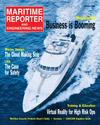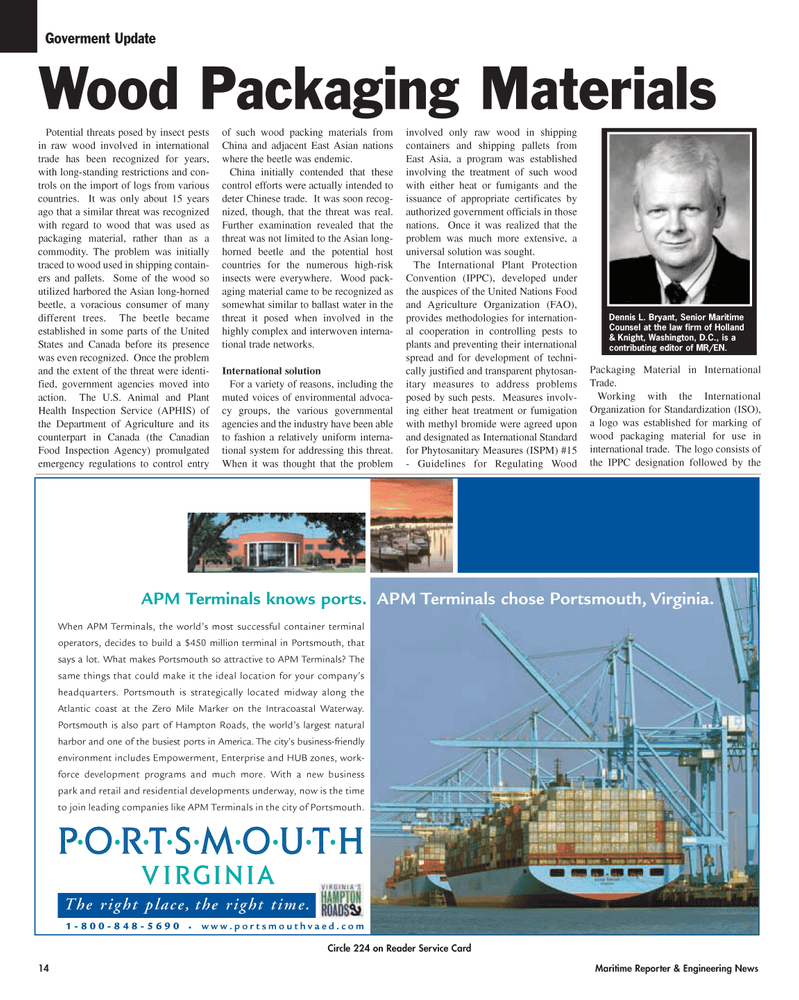
Page 14: of Maritime Reporter Magazine (October 2005)
The Marine Design Annual
Read this page in Pdf, Flash or Html5 edition of October 2005 Maritime Reporter Magazine
14 Maritime Reporter & Engineering News
Circle 224 on Reader Service Card
Goverment Update
When APM Terminals, the world’s most successful container terminal operators, decides to build a $450 million terminal in Portsmouth, that says a lot. What makes Portsmouth so attractive to APM Terminals? The same things that could make it the ideal location for your company’s headquarters. Portsmouth is strategically located midway along the
Atlantic coast at the Zero Mile Marker on the Intracoastal Waterway.
Portsmouth is also part of Hampton Roads, the world’s largest natural harbor and one of the busiest ports in America. The city’s business-friendly environment includes Empowerment, Enterprise and HUB zones, work- force development programs and much more. With a new business park and retail and residential developments underway, now is the time to join leading companies like APM Terminals in the city of Portsmouth.
The right place, the right time. 1-800-848-5690 • www.portsmouthvaed.com
APM Terminals knows ports. APM Terminals chose Portsmouth, Virginia.
Potential threats posed by insect pests in raw wood involved in international trade has been recognized for years, with long-standing restrictions and con- trols on the import of logs from various countries. It was only about 15 years ago that a similar threat was recognized with regard to wood that was used as packaging material, rather than as a commodity. The problem was initially traced to wood used in shipping contain- ers and pallets. Some of the wood so utilized harbored the Asian long-horned beetle, a voracious consumer of many different trees. The beetle became established in some parts of the United
States and Canada before its presence was even recognized. Once the problem and the extent of the threat were identi- fied, government agencies moved into action. The U.S. Animal and Plant
Health Inspection Service (APHIS) of the Department of Agriculture and its counterpart in Canada (the Canadian
Food Inspection Agency) promulgated emergency regulations to control entry of such wood packing materials from
China and adjacent East Asian nations where the beetle was endemic.
China initially contended that these control efforts were actually intended to deter Chinese trade. It was soon recog- nized, though, that the threat was real.
Further examination revealed that the threat was not limited to the Asian long- horned beetle and the potential host countries for the numerous high-risk insects were everywhere. Wood pack- aging material came to be recognized as somewhat similar to ballast water in the threat it posed when involved in the highly complex and interwoven interna- tional trade networks.
International solution
For a variety of reasons, including the muted voices of environmental advoca- cy groups, the various governmental agencies and the industry have been able to fashion a relatively uniform interna- tional system for addressing this threat.
When it was thought that the problem involved only raw wood in shipping containers and shipping pallets from
East Asia, a program was established involving the treatment of such wood with either heat or fumigants and the issuance of appropriate certificates by authorized government officials in those nations. Once it was realized that the problem was much more extensive, a universal solution was sought.
The International Plant Protection
Convention (IPPC), developed under the auspices of the United Nations Food and Agriculture Organization (FAO), provides methodologies for internation- al cooperation in controlling pests to plants and preventing their international spread and for development of techni- cally justified and transparent phytosan- itary measures to address problems posed by such pests. Measures involv- ing either heat treatment or fumigation with methyl bromide were agreed upon and designated as International Standard for Phytosanitary Measures (ISPM) #15 - Guidelines for Regulating Wood
Packaging Material in International
Trade.
Working with the International
Organization for Standardization (ISO), a logo was established for marking of wood packaging material for use in international trade. The logo consists of the IPPC designation followed by the
Wood Packaging Materials
Dennis L. Bryant, Senior Maritime
Counsel at the law firm of Holland & Knight, Washington, D.C., is a contributing editor of MR/EN.
MR OCTOBER 2005 #2 (9-16).qxd 9/29/2005 4:13 PM Page 14

 13
13

 15
15
